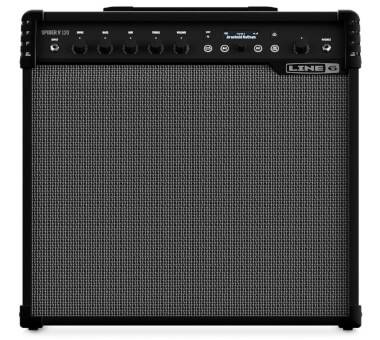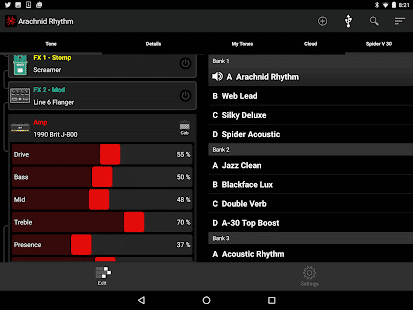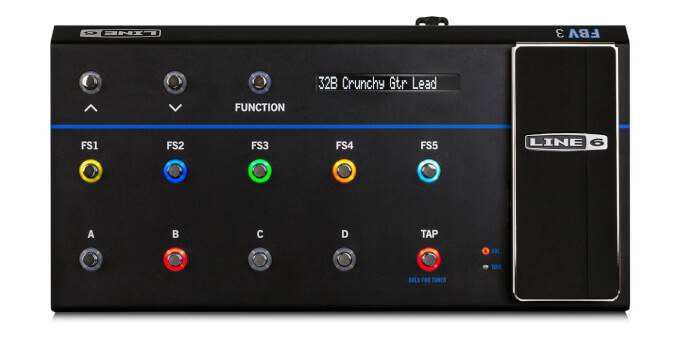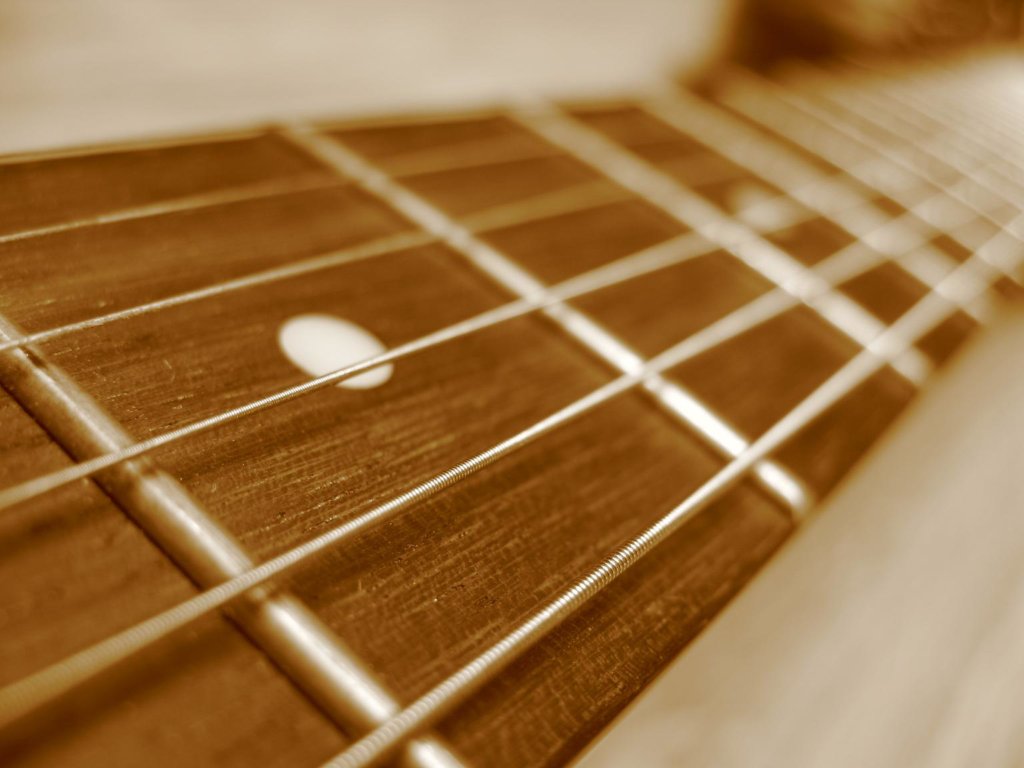A few weeks back I had the privilege of receiving some of Line 6’s latest gear. Like always, I have to dig deep into every feature before I am satisfied. I like to know every detail about the equipment I am using – no surprises at a gig! Now, to be frank, I have not used this new stuff out to a show yet. I set up differently for my current project using a direct connection from the Helix to the PA, and we do not use amps. So for live shows, I am still wired up via the Helix, which is by far the dreamiest piece of gear I have ever owned.

First, the beast itself – the Line 6 Spider V amp.
The school I work for has about 20 rooms between two buildings. We have about 35+ teachers on staff, many of which teach guitar. When it came down to ordering amps, we wanted them all uniform. The entire school features 15w Spider III amps which are wonderful for students to work with both in lessons and when practising at home. They sound warm and full, and provide a nice intro to effects which easily opens the door to conversation when students tinker with the knobs. A few years back I owned a Spider III head which I used with my stack, it was quite the powerhouse. Currently, I own the Spider IV 75w which is a great amp for the musician who needs everything built-in. I had it controlled on the simple little FBV Express MkII foot controller. That controller features control of the built-in 4 channels that reside on the Spider III and IV amps. The IV, however, features a plethora of built-in patches. The 4-channels allow for assignment much like an effects processor. So having worked with the III and IV series, I was excited to see what was new with the V series.
I have the Line 6 Spider V 120, which offers the complete features of the Spider V family. The smaller amps do have a lighter load, and the larger ones are just louder. The highlights? The usual plethora of effects by Line 6 with complete (and I mean full) control and a little practice studio built right into the amp. At 120w, I can honestly say the amp is excellent for live use. I found that it is much lighter in weight than the Spider IV 75w. That is kinda neat! Less weight, much more power. Who would not love that? Load up quickly for the show, hear everything loud and clear! Line 6 provided both a speaker and a tweeter setup which two built-in amps which split the signal to produce an extensive range of tone. How wide? Well, let’s just say this is the first amp I have ever seen that not only sounds fat and bright (as expected) but ADDITIONALLY provides terrific tone for acoustic guitars. You can use the Spider for your electric-acoustic or Variax, and the full-range of sound is wonderful. I plugged my old Variax 700, and 2 of my electric-acoustic guitars (Takamine and Xaviere) and the results were pleasantly the same for all guitars.
Now, if you are a live performer like me and you have enjoyed the benefits of running your Firehawk, HD500x, Helix, etc. directly into the PA system via XLR, I am sure you have realized how great these things sound direct. The Line 6 Spider V features XLR direct-out on the back; this is perfect, you can use the amp to monitor yourself while providing a great signal to the PA without the need to mic the amplifier. Don’t get me wrong; I love a nice tube amp with a sm57 in front of it. However, sometimes a simple setup is a blessing, especially in the world of the gigging cover band musician. Cover bands want to get in, set up without exhausting themselves, and then spend all of their energy on playing and enjoying the show. The Spider V provides just that. Prefer to monitor yourself through your in-ear system? I do. No problem! Run a cable from the headphone port on the Spider V directly to your IEM system. Now you have direct to yourself and direct to the PA. The amp’s speakers bypass when using the headphone port, and all sound patches directly to the appropriate sources.
The Effects.

Line 6 is a digital company. We have to expect great things from their onboard effects. The Spider IV series is was great, but it had its limitations. Line 6 learned from their success with the Firehawk series that while less is more sometimes, in the world of digital effects more is more. The Line 6 Spider V has over 200 amps, effects, cabinets, etc. tossed into its brain. I typically run a basic dirty channel for myself like this:
Noise gate–>compressor–>amp–>cabinet–>post compression–>delay–>reverb
Setting up a chain like that is a breeze with the Spider V. Now, much like the IV, it is a bit time-consuming to set up a patch via the amp itself. The monochromatic screen is still quite small as it was in the Spider IV. That is okay, however, because this is more for just reference. The real magic happens when you plug the amp into either your computer or iOS device. Now, unlike the Firehawk which has Bluetooth, the Spider V has a port on the back to run directly into your iPhone or iPad. That means instant connection, and no connection drops. You could leave an iPad on or nearby the amp and tweak with ease, even during a show! The application for the amp is as easy to use as its cousin which controls the Firehawk. All color-coded effects and amps are on one side of the app, and the patch-listings are on the other side. The cloud allows users to share patches, too. You can use the cloud to download someone else’s excellent patch designs or save yours for future retrieval. I love using the iOS version of the application. The touch-screen system is so intuitive, and on an iPad Pro, the interface is nice and large. I do have one criticism, however. The Firehawk app features separate screens for editing and patch selection. The Spider V’s app tries to squeeze it all on one screen. On an iPad Mini or even an iPad Air, this is a bit unpleasant to look at because of the screen size. I have a 12-inch iPad Pro, and I still prefer the larger interface that the Firehawk has to offer. The benefits of digital technology are that updates are always a possibility. So perhaps Line 6 will adjust this new software in the future with a nice full-screen interface.
The USB is not only for app connectivity!
You can run the amp directly into your computer or mobile device and record using it as both an input device and an effects terminal. Gone are the days of cumbersome devices laying on the desktop. The average joe does not need to set up a studio in his basement which resembles Sony Records or The Hit Factory in NYC. You can just have your favorite software up and ready and plug your amp directly into the computer. Now, in this case, less is more! The amp comes with recording software, but you can use it with any software you choose. I am a big fan of Logic Pro.
Even MORE control.

The iOS app is wonderful, but you cannot press buttons during a gig, right? You need a foot controller. The FBV 3 Pro is the answer. Take a look at the Firehawk floor processor if you have not. The FBV 3 Pro is the same template in design, but smaller. There are five effects bypass buttons and four patch selection buttons. You can easily navigate banks, channels, and toggle effects. Through the application, you can assign which buttons control which features. The color-coded LEDs provide a nice visual aid so you can remember which is which. For instance, all delay effects are green lights. Need delay? Aim for the green LED. The expression pedal can be assigned to control volume, wah, or any parameters for an individual effect like more distortion, faster delay, etc. The tap-tempo button works as expected and completes the layout. What I love about the controller is that it is durable. No cheap parts! Everything is solid and strong. What’s more, it is not a processor; it is a controller. There aren’t any open ports. What’s that mean? Well, you are gigging at a packed house full of drunk college kids. One of them spills his drink all over your floorboard. Not to worry, there aren’t any openings to short this baby out. Just keep a towel on hand and dry it off! I have always had a bit of paranoia about gear getting broken at tighter venues. Being up on a stage is great, but some places leave you on the floor. Damaged gear is not a danger with this equipment.
The ultimate practice amp.
I have always said that the Spider series is great for students. The onboard effects introduce them to effects without the need for a processor or pedals. No additional purchases, it is all built right into the amp. Line 6 took it a step further. They installed a built-in metronome, and some drum loops. Now, let’s talk pros and cons. The drum loops sound great, and with the full-range speaker system of the Line 6 Spider V, you can feel the thump while jamming over the loops. However, oddly enough, there isn’t a way to adjust the tempo of the drum loops. While the lack of tempo adjustment might not sound ideal for everyone, but the variety of loops which included have different tempos and can still provide a good basis for practicing. Students can cue up a drum beat, set up a patch, and jam away. Practicing scales is great with the built-in metronome, too. However, if you are like me and hate the sound of a clicking metronome, the drum loops provide a fun way to practice scales and riffs. I like to look at the positive side of things, and I feel that the loops have their place for the learning musician. As a teacher of 22 years, I have always appreciated any tools which help students learn. The drum loops are among the features which are available all the way down to the smallest of the Spider V amps. Those little 30w amps are perfect for students and hobbyists.
An amp for everyone.
Line 6 has done a great job in providing full-features across every model. You can grab a small 30w amp for practicing at home or a large one for your band. Like having maximum power for your big-production touring band? The Line 6 Spider V 240 is 240w of power pushed through a bi-amped 2×12 setup. Great!
Moreover, finally, my favorite feature….
The Line 6 Relay G-10 Wireless System.

I love wireless freedom. I have an older Line 6 wireless which is great, but it is not “modern.” Line 6 decided to take wireless to the next level. Traditionally, you need a transmitter, and a receiver and all of the above require wires. A wire from your transmitter to your guitar. A wire from your receiver to the amp. A power cable to power the darn thing! I received only the transmitter, not the receiver base. I have not really been able to test-drive the Relay with every piece of gear I own. However, it is not rocket science – it is a wireless connection, and I trust the results are the same across the board. Line 6 removed the hassle of wires by putting the receiver directly inside the amplifier. The Line 6 Spider V has built-in wireless. I have said for years that I could not wait until guitars have built-in transmitters! Perhaps we see glimpses of a future with exactly that feature. I am sure Line 6 will put that into the next family of Variax guitars one day. The transmitter is also wire-free. The device plugs directly into your guitar and the tiny size makes it almost unnoticeable. Now, if you are the type of person who leaves the stage, runs around the venue, or perhaps has the privilege of working the big stages I would suggest a much more robust wireless system. The Relay only has about 50 feet of range. Still, 50 feet is more than enough to provide wireless freedom to any musician on a more than adequate stage. Wireless freedom means:
• No tripping on wires.
• No cables and mess everywhere.
• Spin as much as you want on stage!
Now, in the past one of the hassles of going wireless was changing guitars. You would have to unplug your cable from the guitar, take the pack off of your guitar strap (or if you are like me just dangle the cable and leave the pack in your back pocket.) The Relay is so simple! Just unplug it from one guitar and plug it right into the next guitar; It is as easy to switch the wireless system out as it is to switch guitars. No time lost on stage! If you have ever been in a real professional band, you know that 10 seconds of silence is death on stage. So switching out guitars quickly is essential! Don’t keep your audience waiting.
No more batteries!!
I avoided spending money on batteries every week by buying rechargeable ones. However, that failed when I would race to the show and forget to grab my rechargeables off of the charger! The Relay solves this dilemma, too. Plug the transmitter into the Line 6 Spider V’s input jack and the internal battery on the Relay charges. When the light goes green, you are ready to play! In the time it takes to set up for the show (usually 2 or more hours for a big production band) you can quickly charge up the Relay. The transmitter goes to sleep after a few minutes, so there’s no need to worry about battery usage when you are on break. Strum the strings and the Relay wakes up instantly. Great stuff!
I do like the amplifier and the foot controller. The Relay wireless is my favorite thing of the bunch. I have used countless amps, effects processors, pedals, guitars, etc.; This is the first time a wireless system made me excited! For what I do live, the Helix is still my go-to for big shows. However, I can efficiently use the Line 6 Spider V for (believe it or not) acoustic solo gigs. Even acoustic gigs can benefit from some of the built-in effects like EQ, reverb, chorus, delay, and others. For others, the Spider V is an excellent amp for that “less is more” delivery. I will certainly be suggesting the amp to students in the future, too. With over 720 students at my school alone, I am always on the prowl for what’s best for them. After all, what’s best for the students is best for the teacher; And by extension, the school, too!
Summary:
I would love to see how the Relay works with other gear besides the Line 6 Spider V amps. My dream-rig is a Variax, Helix, a good amp, and a great wireless system. Without the base, the Relay will not be touching my rig, but it does work remarkably well with the Spider V amps. The FBV 3 Pro controller is perfect in many ways. If you want more out of the controller, I’d suggest using an effects processor instead. For efficient control, the FBV is grand. Unfortunately, my old Variax 300, 500, and 700 models are no longer supported by Line 6 tech support. The glitches that happen with the old models do not provide reliability for live shows. I hope to upgrade my Variax one day to the new line of Variax guitars and give a full go to Helix, Relay, Spider V, AND the Variax together. Dreamy!
If you’re a traditionalist who likes tube amps, a Les Paul, and a few pedals – go for it! If you fancy the new digital world and understand how it all works, I have said it before – Line 6 is the way to go. They make a solid product, provide good support, and they do have a great line of products to choose from, too. What started out as just a few amps is now a company that provides great amps, effects, wireless systems, and guitars. Digital heaven.
More Guitar Gear Reviews @ The Blogging Musician



Line 6 has always been inovative. I support them when i can. Keep up good work Line 6